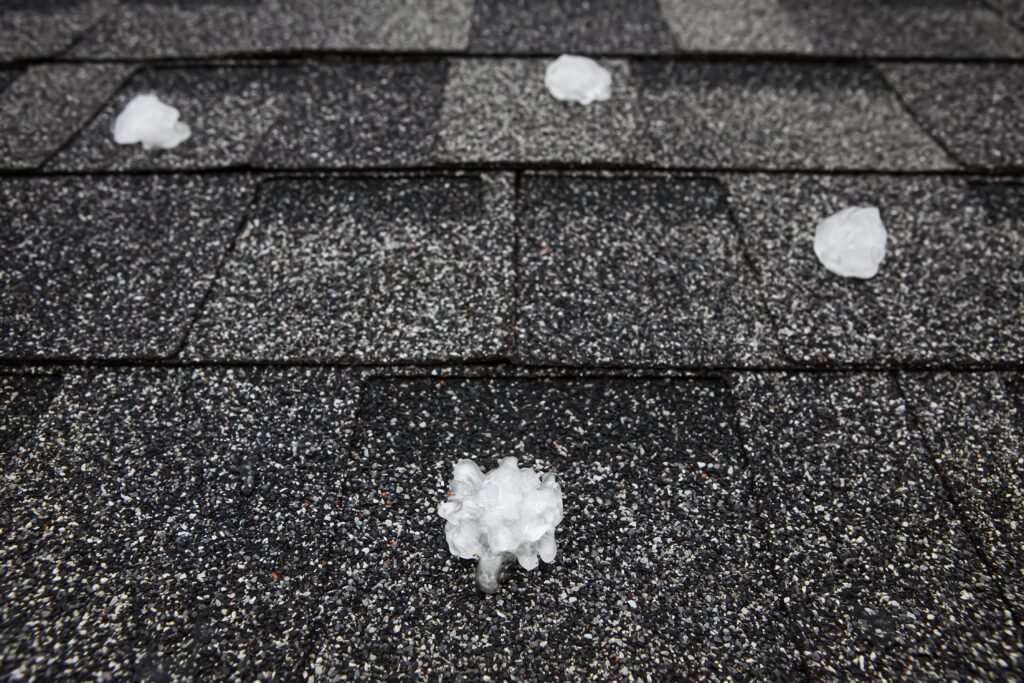What Is Hail Damage and How Does It Affect Roofing Materials?

*Updated September 4th, 2025
Hail damage might sound like a distant concern until you’ve actually experienced it.
Hailstones, depending on their size hail, strike the roof with enough force to cause dents, cracks, and even punctures. While you may not notice these issues immediately, the damage to your roof can compromise protective layers, leading to leaks, water damage, and mold growth down the road.
But not all roofing material is affected the same way. Asphalt shingles, for example, might lose granules (a key signs of hail damage), creating vulnerable spots for future weathering, while a metal roof could show dents but still hold strong. The severity of the roof damage from hail depends on the size of the hail, wind speed, and even the age and material of your roof.
Whether you’ve just faced a hail storm or you’re preparing for the next one, understanding how hail impacts your roof is the first step in protecting your home.
What Size of Hail Causes Roof Damage?
One question that comes up often is, “How big does hail have to be to damage your roof?” The answer might surprise you—it doesn’t always take giant, golf-ball-sized hail to cause problems. Here’s a breakdown of how different size hail can affect roofing material:
Pea-Sized Hail (1/4 inch)
Pea-sized hail is relatively small and rarely causes significant damage to roofs. However, repeated exposure can wear down asphalt and composition shingles, contributing to gradual deterioration. While hail this size may not cause immediate roof damage, it can shorten the life of a shingle roof over time.
Marble-Sized Hail (1/2 inch)
More likely to cause minor damage, especially to older asphalt shingles. Expect damage to asphalt such as granule loss—those protective particles are crucial for UV resistance and water shedding. This type of hail damage on a roof isn’t always obvious but can reduce lifespan.
Dime to Quarter-Sized Hail (3/4 inch to 1 inch)
Hailstones in this range can bruise shingles, crack tiles, or dent a metal roof. Bruising = dark spots where granules are removed—a common signs of damage that can lead to leaks. If you inspect your roof, you may notice scuffed areas and soft spots where the mat is compromised.
Golf Ball-Sized Hail (1.75 inches)
Large enough to cause severe damage to most materials. The force can create deep dents, punctures, and cracks in asphalt or tile and may even damage roof decking, leading to immediate leaks and water damage inside your home.
Larger Hail (2 inches and above)
This size almost always results in hail damage to a roof that may require a full roof replacement. Shattered tiles, large dents in metal roofs, and hail damage to asphalt that leaves the mat exposed are common. A professional roof inspection is essential to determine the extent of the damage.
Assessing the Signs of Hail Damage
Inspecting after a storm is one of the smartest moves to protect your home from hail. The challenge? Hail damage on your roof isn’t always obvious. Here’s how to start identifying roof issues before they become costly repairs.
DIY Roof Inspection Tips
- Dents and Dings: Check metal components (flashings, gutters, downspouts). If they’re dented, your roof likely took hits, too.
- Shingle Damage: Look for visible damage like granule loss (dark, bald spots), bruising, or cracks on asphalt shingles/composition shingles.
- Leaks Inside: Inspect the attic for stains or dampness—early clues of roof leaks caused by hail impacts.
If you spot these, don’t delay. Severity of the damage can escalate quickly.
What Does Hail Damage Look Like on a Roof?
Even minor damage can accelerate wear and tear and lead to storm damage problems like leaks, rot, or mold. On asphalt roofs, granule loss exposes the fiberglass mat, while a metal roof may show cosmetic dents that hint at deeper type of damage.
When to Call a Professional
If damage looks widespread—or you’re unsure—bring in a pro. A certified contractor can inspect your roof, document the extent of the damage, and recommend hail damage repair or replacing the roof if needed.
Insurance Claims for Hail Damage to Your Roof
Filing an insurance claim can feel daunting, but a clear process helps you get fair coverage for damage caused by hail.
How to File a Claim
- Document Everything: Photos of hail damage on a roof and any water damage or property damage inside.
- Contact Your Insurer: Most insurance companies set deadlines for filing a claim for hail—don’t wait.
- Adjuster Visit: Be present to point out all areas where your roof has been damaged.
What to Expect
Adjusters estimate damage repair costs, but their numbers may not match contractor bids. Get multiple estimates to support your hail claim or insurance claim for hail damage.
Tips to Maximize Your Claim
- Multiple Estimates: Strengthens your case if the payout seems low.
- Public Adjuster: Consider one if you need help navigating your insurance policy.
- Due to hail damage specifics: Clarify whether you need new roof materials or a full roof replacement.
Preventing Future Hail Damage
If you live where high winds and hail are common, it pays to plan ahead. The amount of damage can vary by storm, but you can improve how your roof is protected.
Reinforcing Your Roof
- Impact-Resistant Shingles: Upgraded roofing material designed for hail protection can prevent further damage and sometimes earn insurance discounts.
- Reinforce Roof Decking: Strengthening substrate helps reduce damage the roof sustains when hail hits.
Maintenance Tips
- Regular Inspections: Spring and fall checkups help identify hail damage early.
- Clear Gutters/Downspouts: Ensures water sheds properly after storm damage.
- After a Storm: If you suspect roof damage, book a professional roof inspection to assess whether the roof requires repair or replacement.
Cost Considerations for Hail Damage Repair
Understanding costs helps you plan, whether you’re fixing minor damage or severe hail losses.
Repair vs. Replacement
- Minor Repair: Replacing a few shingles may run $300–$1,500.
- Severe Damage: Full roof replacement can range from $5,000–$10,000+ depending on materials and scope.
Budgeting and Claims
Have an emergency fund for damage repair and work closely with homeowners insurance during your hail damage roof claim. If the value of your roof is high or your roof due to hail damage is extensive, replacing the roof might be the most cost-effective long-term choice.
Conclusion
Hail damage is a serious concern for any homeowner. By recognizing what hail damage look like, performing timely roof inspection, and handling your insurance claim strategically, you’ll protect your home from hail and avoid escalating costs.
If your roof has been damaged or you suspect roof damage, act quickly: document the impact of hail, file an insurance claim, and schedule professional hail damage repair to restore and preserve the value of your roof.
FAQs
What does hail damage do to shingles?
Hail can cause asphalt shingles to crack, bruise, and lose granules—classic signs of hail damage. Left untreated, this can lead to leaks and water damage.
Do shingle warranties cover hail damage?
Most warranties exclude damage caused by hail unless you have an impact-resistant product or specific coverage. Check your insurance policy and manufacturer terms; some offer limited protection due to hail damage.
How big does hail need to be to damage a roof?
Hail this size (around 1″) can cause significant damage, especially on older roofs or asphalt systems. Larger stones (2″+) often require hail damage repair or even replacing the roof.
How can I tell if my roof was previously damaged by hail?
Look for dents in metal, visible damage on shingles, granule loss, or interior stains. A pro can inspect your roof and assess the severity of the damage.
Are some roofing materials more hail-resistant?
Yes—metal roof systems and impact-rated composition shingles/asphalt products typically handle hail impacts better and help keep your home from hail damage. better able to withstand the impact of hailstones.
Sources
- Today’s Homeowner – Hail Roof Damage Guide
- Superstorm Restoration – What the Hail?
- Travelers – Identifying Hail Damage to Your Roof
Additional Roofing Resources
- Choosing the Best Roof Coating for Your Home
- Do You Need a Drip Edge on Your Roof?
- Protecting Your Home from the Hidden Dangers of Clogged Gutters
- Flat Roof Replacement Cost

Anna has over six years of experience in the home services and journalism industries and serves as the Content Manager at MyHomePros.com, specializing in making complex home improvement topics like HVAC, roofing, and plumbing accessible to all. With a bachelor’s degree in journalism from Auburn University, she excels in crafting localized, comprehensive guides that cater to homeowners’ unique needs. Living on both coasts of the United States has equipped her with a distinctive perspective, fueling her passion for turning any house into a cherished home through informed, personalized decision-making.
Connect with top-rated local contractors who can help you with siding, roofing, HVAC, windows, and more. Get free quotes from verified professionals in your area today.








